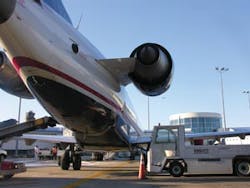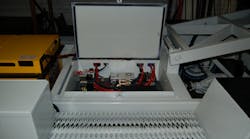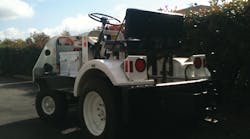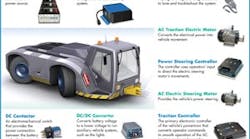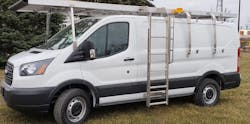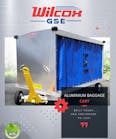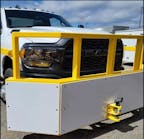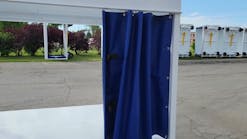On an unusually frigid day on the ramp at Charlotte-Douglas International Airport, US Airways Express operations are running smoothly a few days after a weather event. The gates are bustling with activity as crews work to turn each plane, handling an average of 300 flights daily.
Across the way from concourse E, a GSE area features two rows of battery chargers where electric vehicles receive a boost when not in use. However, at this particular time in the afternoon, the chargers stand alone.
Fred Maslow, analyst-station resource allocation at US Airways Express operated by Piedmont Airlines, points to the deserted chargers as an example of the electric units’ popularity among the operators. “The electric units are always the first tractors to leave the motor pool,” he says.
For Piedmont, the units’ popularity is one affirmation of its goal to introduce electric GSE into its fleet. With the recent acquisition of electric bag tractors and lavatory trucks, the carrier plans to move forward with implementing additional units in the future.
A Plan in Motion
Piedmont Airlines began considering electric equipment during the fuel spike in 2008. Looking to replace a portion of its aging fleet with cost-effective and environmentally friendly units, they decided upon electric.
To set the pieces in place for introducing electric equipment into the fleet, the carrier worked in cooperation with Mecklenburg County and the airport. In 2009 it received funding from the county to offset some of the cost for purchasing 20 new electric bag tugs. The airport agreed to purchase and install the chargers.
After extensive testing at stations in Charlotte and Philadelphia, Piedmont implemented the 20 new electric bag tugs in CLT, which represents about 20 percent of its fleet of tugs at the location. With its own capital, the carrier then purchased six electric lavatory vehicles.
Equipment Features
The units feature a 625-amp lead-acid battery with a single-point watering system. The carrier decided to independently purchase batteries for the units, choosing a model that is larger than a standard 500-amp battery to provide an operational cushion.
“Unexpectedly, we needed that capacity anyways,” says Brian Wemple, manager — customer service support at Piedmont. “There used to be a path where our drivers would cut through to reduce the drive time. This path is now currently closed because of airport construction, so people have to drive longer distances now, and we never considered that. It’s a long way because of that, so the extra capacity has been a big success.”
Piedmont also opted for cabs on the units in which they have placed small heaters for driver comfort during winter operations. “From what we’ve heard, it’s been good,” Wemple says. “Our big concern was that we were going to be burning the battery of the tractor, but we haven’t been having any known issue. You just need to find an efficient heater.”
Implementation and Results
The implementation of the new units with workers on the ramp has been a success, according to Wemple, adding that much of the work involved training operators to charge the units when needed — which is usually overnight to allow the vehicles to be fully functional throughout the next day.
“There’s been a little bit of a learning curve,” he says. “We had to be on top of our game, ensuring everyone had everything they need to make sure it worked. I think that we all executed it well, and we had great vendor support. The operation grabbed it and took off with it. It was a simple transition, really.”
A bigger difficulty, perhaps, came in the form of easing doubts about electric. “It was a challenge to introduce electric, because there was a lot of skepticism out there,” Wemple says. “I think we’ve fortunately overcome most of that skepticism with the success we’ve have with the units in Charlotte here.”
The units’ popularity among drivers has meant greater hours of use — which has been good news for the airline, as well as the county. “One of the requirements of the Mecklenburg County grant is basically bi-annually we report the number of hours we’ve used on the equipment,” Wemple says. “The funding amount they provide is somehow related back to the emissions you’re proposing to reduce. They want to ensure that we are performing to what we had originally proposed.
“We’re very happy to say that we’re actually exceeding what we had originally expected in terms of hours usage on the vehicles, which is good all around, because the more we use the electric vehicles, the more it benefits us from a cost perspective. Obviously, the more we use the electric vehicles the better it is for the environment and the county as well,” he says.
The overall run-time of the units has translated to a 28-percent reduction in fuel cost, according to Maslow.
The carrier has also benefitted from a reduction in maintenance needs. The units require less support than some other types of equipment, according to Maslow. “They require some maintenance; we do have to pull them in just like everything else, but there are no oil changes,” he says. “It’s quite simple by comparison. The maintenance is way down.”
He continues, “There are also benefits that you don’t even recognize when you’re in our position of sourcing the equipment: They’re easier to get in and out of. They’re lower, so you’re not climbing up. They’re quiet, and you never have to worry about starting.”
On the horizon
The carrier does not plan to slow down with its electric ambitions. Maslow says they are now testing electric towbarless pushbacks in CLT – with a goal of implementing them into service in 2011.
Piedmont Airlines is also looking outside CLT to its operation in Philadelphia, where the airport recently finished installing 23 chargers.
The airline has received funding from the state to replace equipment with electric, which it has planned to acquire in the coming months.
“In the state of Pennsylvania, we’ve been awarded the opportunity to use up about $300,000-400,000 dollars of grant funding total,” Wemple says. “We’ll be looking to utilize available grant funding that’s been awarded to the company to help offset the purchase of somewhere between 30 to 40 pieces of electric ground equipment this year — close to a 50/50 mix of baggage tractors and belt loaders.”
All equipment needs to be in place by the end of June, so we expect that equipment should be in place mid-year,” Wemple says.
He adds, “It also gives us room to look at future projects in 2012 and 2013.”
